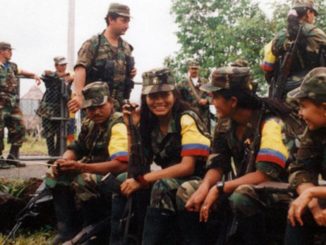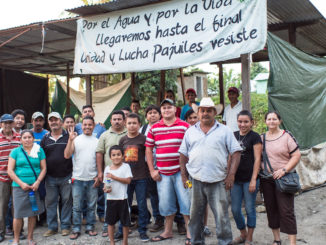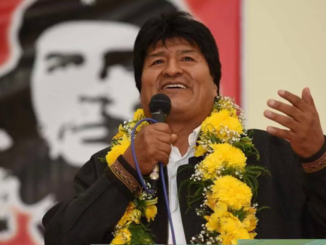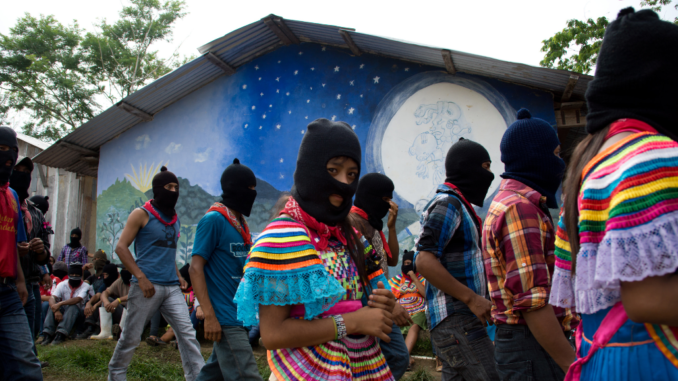
To analyze the state of Latin American social movements today, we must review the main popular struggles since 2005, when the previous cycle of struggle concluded with the second gas war in Bolivia and Evo Morales’ electoral triumph.
A mapping of these resistances will give an idea as to what is happening to counter the advance of the right wing and the retreat of the left in the electoral scenario. As we see in the following table, new social actors appear from 2005 onwards, while others are dispersed. The bottom line is the consolidation of the energy extractivism model, which involves the re-colonization of territories and peoples, and excludes a considerable part of the population, particularly Indians, Blacks, mestizos, peasants, and urban popular sectors – whom I refer collectively to as los de Abajo, those from below.
Movements that played an important role in the previous cycle of struggles, like the Piqueteros in Argentina, are no longer prominent or have simply dispersed, while the Landless Movement in Brazil has lost its impact on the national political agenda. Others such as the Mapuche movement and Zapatismo have reconfigured or intensified their struggle, while collective acts of resistance against the extractive model have increased, in particular struggles against open pit mining and soy monoculture. A striking reconfiguration of the map of resistance shows that no social actors have a truly national profile as there were in the previous period (with the exception of Zapatismo), although local actions do sometimes have national and global repercussions.
Principle Post-2005 Struggles
| EZLN La Otra | México | 2005 | Sixth Declaration of Selva Lacandona |
| Oaxaca Commune | México | 2006 | Indigenous and popular urban / Women |
| Minga por la Vida | Colombia | 2008 | Indigenous, Black and popular |
| Baguazo | Perú | 2009 | Amazonian Indigenous uprising |
| Gasolinazo | Bolivia | 2010 | Popular semi-uprising |
| Parque Indoamericano | Argentina | 2010 | Popular urban sectors for housing |
| Mapuche strikes | Chile | 2010 | Hunger strikes for prisoner release |
| Education struggle | Chile | 2011 | Schools and popular sectors |
| TIPNIS March | Bolivia | 2011 | Indigenous with urban support |
| Cherán | México | 2011 | Urban Indigenous against mafias |
| Conga Resistance | Perú | 2012 | State of Seige for mining in Cajamarca |
| June Days | Brazil | 2013 | 20 million in the streets of 353 cities and towns |
| Agricultural Strike | Colombia | 2013 | Farmers, transport workers, students |
| Acampe Malvinas Arg. | Argentina | 2013 | Camp and actions against Monsanto |
| Ayotzinapa | México | 2014 | Mass movement for life of disappeared |
| Ni Una Menos | Argentina | 2015 | 300,000 in Buenos Aires, Chile/Uruguay |
The picture is incomplete; to list all of the struggles and resistances would be impossible. Some collective processes, such as resistance to the Conga mine in Peru drew attention to the multiple struggles across the country to transnational mega-mining, while the resistance in the Celendín (Cajamarca) region remains important after the conflict in 2012. In general during this current cycle, acts of resistance are semi-subterranean processes that only occasionally result in widespread mobilizations.
It seems necessary to highlight some characteristics of the social movements in this new period while keeping in mind that territorialization remains a fundamental aspect. This new phase of the movements coincides (and responds) to the hegemony of the energy extractivist model, which implies confrontation between two logics: the colonial-extractive, and the anti-colonial and anti-patriarchal, which are intertwined in their anti-capitalist logic.
The first characteristic is that the movements resist and create at the same time. This is probably the main feature in the current period. The fact that they resist is evident and needs no further explanation as it is the dynamic of all movements, always. But something quite particular is happening: in energy extractivist societies, those from below have only a subordinate role, without dignity, and thus, no place. That is why it is necessary to create – here and now – space where they can feel secure and protected, space as a refuge where they can “breathe,” space that, if possible, they control and defend themselves.
For the same reasons, women’s groups create women-only spaces. Contrary to what men might perceive, these spaces are not created for ideological reasons or out of resentment. Here women can speak openly without being reproached, and feel at ease among sisters; women’s spaces offer material and symbolic security in a self-controlled space/time.
In these spaces they can create relationships that do not reproduce the hegemonic world –hierarchical, patriarchal, colonial, and capitalist. Here they can open themselves to relationships of reciprocity and complementarity, dismantling the old vertical structure, and in the process, form different relationships with nature, with other humans, and nonhumans.
This is what is happening in many spaces where education and health do not work to the logic of the market but to empower people and communities. These are spaces where nature is cared for and time is made for mysticism, for dance, and for music. It is the daily practice not only of the Brazilian Landless Workers Movement and the Zapatistas, but also of urban democratic spaces such as the Acapatzingo community in Mexico City and other self-managed collective groups across the region that act as a countercurrent to the system.
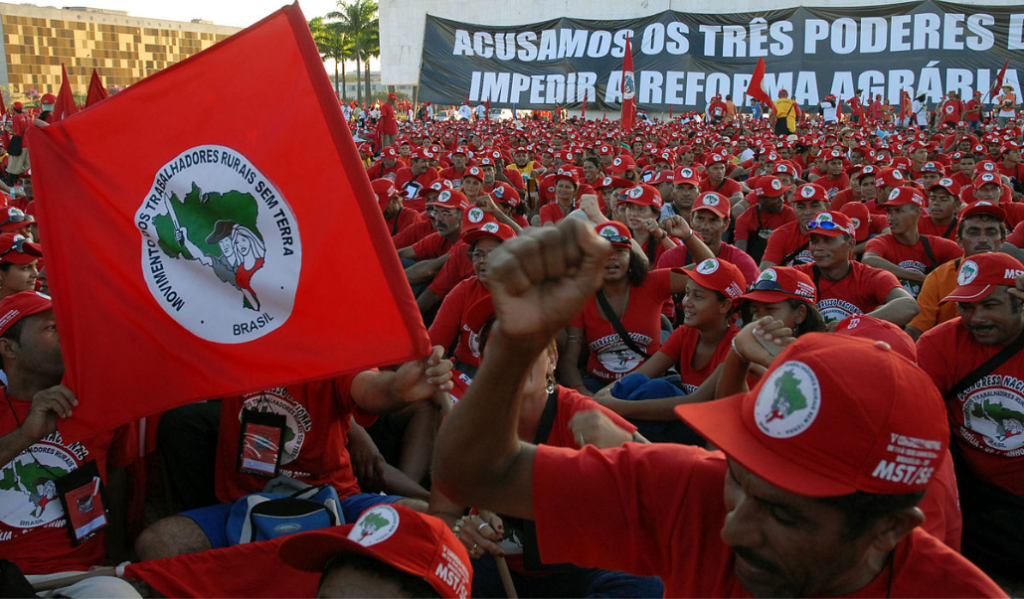
This “other world” does not exists as a whole, except in the case of Zapatismo, where hundreds of communities grouped in more than 30 autonomous municipalities organize the daily practices that make up a new world – from self-managed schools and clinics to agriculture without agrochemicals, from controlling organs of power and justice, to defense of the autonomous territory.
But the most common characteristic is that social movements organize some of the necessary practices to sustain life – prioritizing education, training, health, and sometimes production. These practices are like individual threads that make up an enormous textile that the people and communities are beginning to weave, while the state and capital unravels it in so many ways – through assistance policies, by allowing extractive multinationals into their territories or by state repression.
The 5,000 residents of the self-managed neighborhood of Acapatzingo, Mexico, have organized their own autonomous water service by supplementing the state service with rainwater storage and their own wells. Although they do not have complete food autonomy, a couple of large horticultural projects supply the community with vegetables, in addition to a school, a health center, and a community radio station. They are in the process of walking towards full autonomy and exploring new possibilities but, all things considered, the community is still far from being an “other world.”
Nevertheless, although this “other world” does not exist, it exists in a sense in the practices of the communities. On occasion, these practices have their own “non-state institutions” – extensive and more or less permanent – such as the Zapatista Councils of Good Government, the cabildos in the Cauca, the “campfires” in Cherán, or the barricades in Oaxaca (during the insurrectionary months of 2006); they are present in the assemblies of the recuperated factories and the various diverse forms of decision-making in many territories. To say “institution” sounds somewhat hollow, because in reality it is communitarian common sense that is being put into play in such organizations.
The second characteristic is the double centrality of community and reproduction, placing families – revolving around women – at the center of the movements. The community is the political form that the people assume to resist and, in doing so, they change the world by changing the place that they occupy in it. Communities do not pre-exist as collective practices, they are the product of struggle and resistance. In the process of resisting, of standing up as collective subjects, the people create/re-create ways of relating that we call communities. In this point the class concept of E.P. Thompson serves as a reference: class is a product of struggle, it does not preexist as if it were two boxers facing one another (Thompson, 1989).
But the most common characteristic is that social movements organize some of the necessary practices to sustain life – prioritizing education, training, health, and sometimes production. These practices are like individual threads that make up an enormous textile that the people and communities are beginning to weave.
In Latin America we can affirm that in the last half century popular struggles have contributed to the creation of a multitude of communities, among Indians, Blacks, mestizos, and among the poor of the city and the countryside. In Cheran, Mexico, for example, when the inhabitants of this small P’urhépecha town rose to defend their territory from the mafias that had cut down 80 percent of their communal woods, they did so with a return to traditional p’urhépecha modes of organizing:
At dawn on April 15, 2011, a group of women and young people decided to confront the armed criminals and expel them permanently from the territory. The community remembers this day as the moment when they said – Enough! And a self-defensive social movement was forged for security, justice and the reconstitution of the territory. This movement developed with the creation of the Council of the Government elected following traditional customs and practices, and in the process, revitalizing forms of communitarian organization.
The agreements reached in the first days of the movement involved strategies for survival: first, community members were asked not to leave the territory unless a matter of urgency and at one’s own risk; second, barricades and campfires were installed as checkpoints around the periphery and at strategic entrance points of the community; third, all residents were asked to gather on street corners, to light campfires and to remain alert. Firecrackers were used for communication to indicate calm or as alarms for mobilization. In addition, a dry law was imposed in the community, to ensure that all were able to react immediately in the event of reprisals. Thus the campfires were placed at the cross-roads as a strategy of resistance and protection. They were organized according to the initial agreements and functioned in a spontaneous manner; neighbors brought kitchen utensils, tables, chairs, improvised benches, constructed an altar, erected makeshift roofs and used planks to mark the space of the campfire.
From the start, the participation of women was indispensable for keeping the campfires going, preparing food and taking care of the children. They also participated in strategy making and consolidated the wellbeing of the community through their prayers. With the campfires lit day and night, the children were drawn in to play and eat and in that way, participated and learned about the situation with their parents and relatives (Velázquez and Lepe, 2013: 63).
This extensive description condenses three aspects of the movement: its communitarian character (revitalizing forms of communitarian organization), the central role of women (and young people), and the emphasis on reproduction. These are three characteristics weaving together to form everyday life, while the campfires – that is to say, the appropriation of space – represent the territorialization of the movement. What we see is that the community-reproduction-women trilogy is impossible to untangle or separate. The movement rebuilds the territory through more than 240 bonfires in the four barrios that comprise Cherán, which serve as points of territorial control by the community being reconstructed around the campfire. At the same time, the campfires are communitarian and feminine spaces: the community gathers and stays together around the fire, meeting as equals, cooking and eating together, and sharing time with the children in a family/community-based space that, naturally, is the space of women. Although men participate, this space is feminine in a profound sense: it establishes, embraces, includes.
As Brazil’s left looks for a path out of political crisis, pairing base-building with politicizing efforts is key. https://t.co/jBWZyutTnq pic.twitter.com/WsTv637iWJ
— UpsideDownWorld (@UpsideDownTweet) September 19, 2017
The third characteristic is the widespread growth of the role of women and young people. This is different from saying that women and young people play a relevant role in the movements, as we asserted 15 years ago. This characteristic follows naturally from the previous one, because they are community-based movements focused on reproduction, women and their children occupy a prominent place. In this way, the movements become anti-patriarchal. This does not materialize automatically from the large-scale presence of women and young people, but is anchored in the importance of collective or communal work, which is one of the ways in which the community controls the reproduction of daily life (Tzul, 2015).
K’iche’ Maya sociologist Gladys Tzul asserts that in societies based around communal work there is no separation between the sphere of domestic society which organizes reproduction, and political society which organizes public life. Both, explains Tzul, sustain and feed off each other mutually. The political sphere is not subordinated to the domestic, as occurs in Western class society, since in the communities a level of complementarity is created between the two domains through communal government. “The Indigenous communal government is the political organization to guarantee the reproduction of life in the communities, where k’ax k’ol (communal work) is the fundamental base upon which those systems of communal government rest and are produced, and where everyone participates” (Tzul, 2015: 133).
Collective/communal works allow the reproduction not only of material goods but also the community as such, from the assembly to celebrations to rituals like funerals. Communal life lends itself to forging alliances with other communities at a national or international level, and to engaging in the resistance struggles that ensure its reproduction.
Tzul also observes an aspect that is central in the resistance to patriarchy: working together communally increases the possibility of neutralizing the patriarchal oppression of patrilineal inheritance, which excludes women. “Men and women who come from other communities and do not belong to kinship alliances” explains Tzul, “are gradually, while doing k’ax k’ol, producing their own kinships” (Tzul, 2015: 137).
Communities exist because working collectively produces communal life. Collective works are social relations, the ways in which communities reproduce, create and sustain the commune. That is why the role of women, and young people, is so important and goes beyond a quantitative question. Reproduction is more powerful than production: strong bonds are forged between human beings, and with nature and the environment. In this sense, reproduction can save us from the destruction caused by capitalism.
Read From Social Movements to ‘Other’ Societies in Movement – Part 2.
Translation by Ramor Ryan.
Raúl Zibechi is a Uruguayan writer and one of the best known political analysts in South America.
Copyright, Upside Down World. May not be reprinted without permission.

